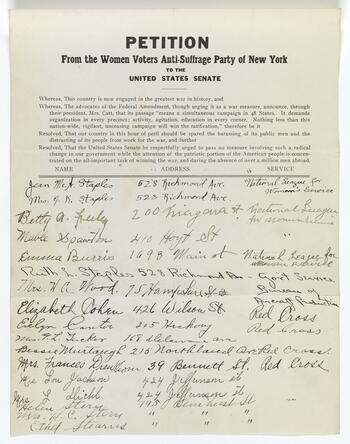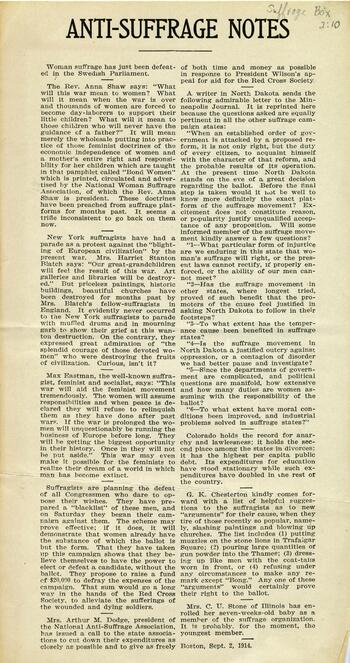By the time the Great War began in Europe in July 1914, suffrage organizations in New York were large enough and diverse enough to enable members to have several different points of view. Many suffragists, such as Crystal Eastman, adamantly opposed war and belonged to peace parties and similar organizations. Some suffragists refused to engage in any activities related to war work, such as selling war bonds, because they had no voice in deciding whether or not the country should go to war in the first place. Members of the Woman’s Party, which had split from the National American Woman Suffrage Association, held vigil outside the White House, confronting President Wilson for his hypocrisy in fighting for democracy in Europe, while denying it to the women citizens at home. Arrested and force-fed when they conducted hunger strikes, they won sympathy and brought new attention to the cause. However, many suffragists supported war preparedness and Red Cross efforts, raised money for airplanes and ambulances, sold war bonds, and gathered information on the talents and resources of individual women who would be available to help the government in the event that men had to serve overseas. At the same time, virtually every anti-suffragist supported war preparedness, and later, the war effort itself.
Petition from Women Voters Anti-Suffrage Party of New York to the Senate, 1917. The petition asked that the U.S. Senate “be respectfully urged to pass no measure involving such a radical change in our government while the attention of the patriotic portion of the American people is concentrated on the all-important task of winning the war.” Courtesy of Center for Legislative Archives via National Archives and Records Administration.
Anti-suffrage political cartoon containing text, "Remember! That if you do not fight against suffrage you do, by your indifference, fight with these allies for suffrage!". "Allies" are listed as Feminists, Mormons, and Socialists. Courtesy of Clinton Historical Society via South Central Regional Library Council.
Anti-Suffrage Notes, Sept. 2, 1914. This issue criticizes New York suffragists for exploiting the war in Europe to advance their “feminist” cause. Courtesy of Claremont Colleges Library.


